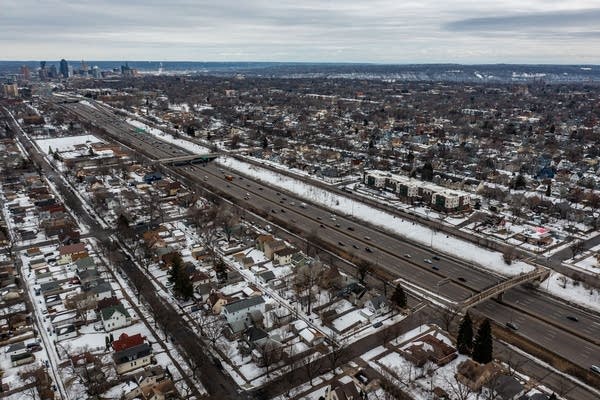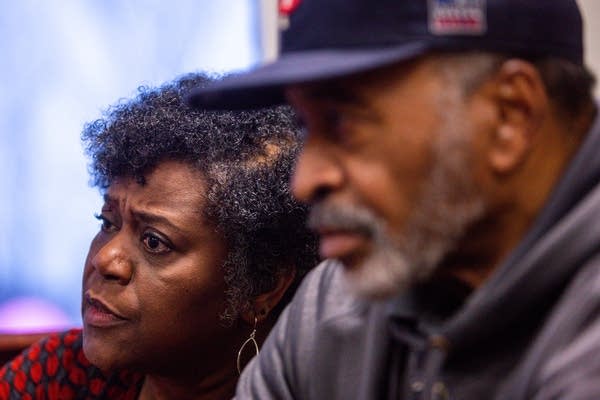As state considers repairs to I-94, Rondo residents look for reconnection
Efforts to restore the historic, largely Black neighborhood should include people most impacted by freeway construction
Go Deeper.
Create an account or log in to save stories.
Like this?
Thanks for liking this story! We have added it to a list of your favorite stories.
The break room inside of Taste of Rondo Bar and Grill overlooks a well-traveled portion of Interstate 94 in St. Paul.
An estimated 160,000 vehicles per day travel the stretch of I-94 between Minneapolis and St. Paul, according to the Minnesota Department of Transportation. As the cars sped past on a recent weeknight, Robin Hickman-Winfield and her husband Steven Winfield wondered how many of those travelers know about the history of Rondo.
“Just imagine,” Robin said. “Our homes and businesses again.”

The walls of the restaurant are lined with black and white photos depicting past generations of Black families enjoying life in Rondo. Pictures of members of Robin's own family also adorn the menu.
Turn Up Your Support
MPR News helps you turn down the noise and build shared understanding. Turn up your support for this public resource and keep trusted journalism accessible to all.
"This is my father, Bobby Hickman and uncle Gordon Parks," Robin said, using her finger to point them each out.

Bobby Hickman was a community activist and educator and Gordon Parks was a renowned photojournalist and artist whose works highlighted the Rondo neighborhood.
When she first saw the menu, “I just boo-hooed,” Robin said. “We are Rondo.”
Named for an early settler, Rondo Avenue was the heart of the largest Black community in St. Paul from the 1930s through the 1950s. The surrounding neighborhood stretched into today’s Summit-University neighborhood and north to University Avenue.
There are many stories of generations of Black families that prospered even with the challenges that came from building I-94, Robin explained. But 1,000 or so family homes and businesses were demolished to make room for the highway and the effects linger in lost opportunities to build generational wealth.
“I am taking my rightful place in reclaiming what was stolen from us,” Robin said.
Robin and her husband Steven are spreading the word anywhere they can about an idea called the Land Bridge. The goal is to reconnect the vibrant community that was split in two by the construction of I-94 from 1956 to 1968. The bridge would serve as a cap over the part of the highway that encompasses what used to be the entire Rondo neighborhood.
Steven has fond childhood memories from the old neighborhood.
"Whether it was here or on the other side of University, Frogtown or wherever, people were just close and cared about each other," Steven said.
When Steven was growing up in St. Paul's Rondo neighborhood in the ‘50s and ‘60s, it was as if I-94 was growing along with him.
It started as a giant hole in the ground Winfield and his baseball teammates would run through during practice.
"That’s one of my fondest memories is wondering ‘What is this hole they are digging here?’"
The new east to west interstate highway would eventually connect people all over the region, but for Steven Winfield’s family and many other Black families, it meant their homes were chosen by the government to be demolished.

The Winfield name would go on to become part of baseball history as Steven and his brother Dave grew up to play professionally. Dave was inducted into Major League Baseball’s Hall of Fame in 2001.
ReConnect Rondo — The Land Bridge

“Now is the moment,” says Keith Baker. “We will not be in this moment again.”
Baker is the executive director of ReConnect Rondo, the advocacy organization that has been studying and planning the Land Bridge idea for more than five years.
Baker secured $6 million from the state last year to continue developing the idea and say the descendants and current residents of Rondo should be at the center of planning the project and what is built on top of that land bridge.
“To generate the economic opportunities that stay within the community for wealth-building,” Baker said.
MnDOT has been working on a project called Rethinking I-94 since 2016. The goal is to make needed repairs to the aging infrastructure, while creating methods to reduce further harms caused by the freeway. Metro deputy district engineer Sheila Kauppi said the aftermath of the murder of George Floyd in 2020 represented another moment to reflect and listen.
“It has pivoted from where we were in 2016 to where we are now,” Kauppi said. “We listened to a lot of people, we learned a lot about the community.”
Kauppi said MnDOT does not currently have funding for anything beyond the most needed repairs to maintain the infrastructure that already exists along the entire 15-mile stretch of the project between the Twin Cities. It encompasses the stretch of I-94 between Broadway Avenue in Minneapolis and Highway 61 in St. Paul.

Kauppi said MnDOT is in the process of gathering public input to consider any proposed project alternatives and plans to have some initial plans ready to release in late summer. The next steps for I-94 will take 15 to 20 years to implement.
“We are making a long-term effort to engage with communities, making sure we are making decisions with the community context that we have,” Kauppi said. “Recognizing cities and counties have built economies around the I-94 corridor.”
MnDOT has about a dozen examples of highway caps and buildings over highways including Target Field, Lowry tunnel in Minneapolis and Superior Street Bridge-Cap in Duluth.
Baker said the land bridge across the Rondo community would rely on a combination of public and private funds, and could cost more than $450 million to complete.
“So, you can see, the land bridge is just simply the tool for catalytic economic benefits,” Baker said. “Housing benefits, open park space benefits, all of the amenities that we know improve quality of life.”
Our Streets — Twin Cities Boulevard

Another alternative proposal for I-94 emerged this year that suggests ripping out the entire stretch of the highway MnDOT is considering and replacing it with various modes of travel. The idea is called Twin Cities Boulevard.
The Minneapolis nonprofit Our Streets aims to make cities more easily accessible to bikers and walkers. The group’s plan still includes some driving lanes, which Our Streets argues would accommodate locals who mostly use the freeway to make shorter trips. Others traveling between suburbs or through the state could use alternatives like Interstate 694.
On a recent unseasonably cold evening, Our Streets transportation policy coordinator Alex Burns was knocking on doors to raise awareness about Twin Cities Boulevard. Two next-door neighbors living right next to I-94 told him they did not know big changes were even being considered.
The two houses were split on the idea of a freeway-to-boulevard conversion as they looked at the renderings.
Burns said the idea also would center communities along I-94 that experienced demolition along with other economic and environmental harms.
“A difference we have tried to make clear is we feel like a land bridge over a reconstructed or expanded freeway, that cements I-94’s harms for another half-century is an unacceptable outcome for this project,” Burns said.
Keith Baker of ReConnect Rondo said Our Streets never tried to work with his organization ahead of releasing its plan.
“It fails to recognize the extraordinary time we are in post-George Floyd, and the disparities that exist in the state of Minnesota,” Baker said.
MnDOT will consider both ideas.
A vision of possibility

For the Winfield’s, their family stories are more than a window to the past, they are lessons for the future.
“I drive around St. Paul and see representations of community Utopias,” Robin said. “Why not us?”
Robin and Steven chuckled as she referenced the Black Utopia in the movie Black Panther.
“I’ve had folks laughing talking about ‘Rondo Wakanda forever,’” Robin said. “Why not? Our children need to have that vision of possibility.”



